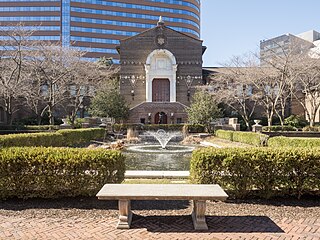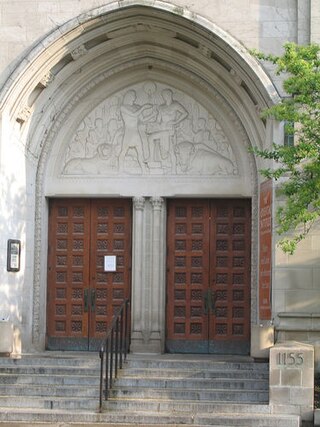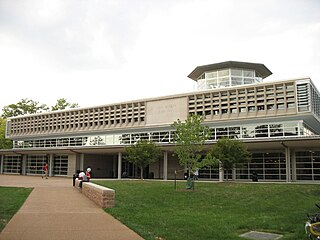
Penn Museum, formerly known as The University of Pennsylvania Museum of Archaeology and Anthropology, is an archaeology and anthropology museum at the University of Pennsylvania. It is located on Penn's campus in the University City neighborhood of Philadelphia, at the intersection of 33rd and South Streets. It also is close enough for Drexel University students to walk or take SEPTA transportation services. Housing over 1.3 million artifacts, the museum features one of the most comprehensive collections of Middle and Near-Eastern art in the world.

The Institute for the Study of Ancient Cultures, West Asia & North Africa, established in 1919, is the University of Chicago's interdisciplinary research center for ancient Near Eastern studies and archaeology museum. It was founded for the university by Egyptology and ancient history professor James Henry Breasted with funds donated by John D. Rockefeller Jr. It conducts research on ancient civilizations throughout the Near East, including at its facility, Chicago House, in Luxor, Egypt. The institute also publicly exhibits an extensive collection of artifacts related to ancient civilizations and archaeological discoveries at its on-campus building in Hyde Park, Chicago. According to anthropologist William Parkinson of the Field Museum, the ISAC's highly focused "near Eastern, or southwest Asian and Egyptian" collection is one of the finest in the world.

Yeungnam University is a private research university located in Gyeongsan, North Gyeongsang, South Korea. The university's predecessors, Taegu College and Chunggu College, were founded in Daegu in 1947 and 1950 respectively. In 1967, the two colleges were merged by President Park Chung Hee to form Yeungnam University. In 1972, the university's new main campus opened in Gyeongsan east of Daegu. The university includes colleges of Law and Medicine as well as a university hospital. It ranked 1st in the rate for passing the bar exam for the second straight year (2015~2016), it also ranked 6th in providing CEOs in Korea's top 100 companies (2015), and 6th in providing the CEOs in Companies listed on KOSDAQ (2014). Yeungnam University is ranked 501 in the Academic Ranking of World Universities by Shanghai Jiao Tong University.

Jamia Millia Islamia is a premier central university located in New Delhi, India. Originally established at Aligarh, United Provinces during the British Empire in 1920, it moved to its current location in Okhla in 1935. It was given the deemed status by University Grants Commission in 1962. Jamia Millia Islamia became a central university in the year 1988 by an act of the Indian Parliament which was passed on December 26, 1988.

The Tokyo National Museum or TNM is an art museum in Ueno Park in the Taitō ward of Tokyo, Japan. It is one of the four museums operated by the National Institutes for Cultural Heritage, is considered the oldest national museum in Japan, is the largest art museum in Japan. The museum collects, preserves, and displays a comprehensive collection of artwork and cultural objects from Asia, with a focus on ancient and medieval Japanese art and Asian art along the Silk Road. There is also a large collection of Greco-Buddhist art. As of April 2023, the museum held approximately 120,000 Cultural Properties, including 89 National Treasures, 319 Horyuji Treasures, and 649 Important Cultural Properties. As of the same date, the Japanese government had designated 902 works of art and crafts as National Treasures and 10,820 works of art and crafts as Important Cultural Properties, so the museum holds about 10% of the works of art and crafts designated as National Treasures and 6% of those designated as Important Cultural Properties. The museum also holds 2,651 cultural properties deposited by individuals and organisations, of which 54 are National Treasures and 262 are Important Cultural Properties. Of these, 3,000 cultural properties are on display at one time, with each changing for between four and eight weeks. The museum also conducts research and organizes educational events related to its collection.

Cultural heritage is the heritage of tangible and intangible heritage assets of a group or society that is inherited from past generations. Not all heritages of past generations are "heritage"; rather, heritage is a product of selection by society.

Lakkundi, also referred to as Lokkugundi, was a major city prior to the 14th century, and is now a village in Gadag District of Karnataka, India. By 10th century, it was already a major economic and commerce center with mint operations for South India, one mentioned in Kannada and Sanskrit inscriptions and texts. By 12th century, many Hindu and Jain temples had been consecrated here, along with public infrastructure such as stepwells and water reservoirs. Among the major temples are the Brahma Jinalaya (oldest), Mallikarjuna, Lakshminarayana, Manikeshwara, Naganatha, Kumbheshvara, Nanneshwara, Someshwara, Narayana, Nilakanteshwara, Kasivisesvara, Virabhadhara, Virupaksha, and others. As its importance and wealth grew, Lakkundi became one of the capitals of the Hoysala Empire.

Indira Gandhi National Centre for the Arts (IGNCA), New Delhi is a premier government-funded arts organization in India. It is an autonomous institute under the Union Ministry of Culture.

Avery Architectural and Fine Arts Library, the world's largest architecture library, is located in Avery Hall on the Morningside Heights campus of Columbia University in New York City. Serving Columbia's Graduate School of Architecture, Planning and Preservation and the Department of Art History and Archaeology, Avery Library collects books and periodicals in architecture, historic preservation, art history, painting, sculpting, graphic arts, decorative arts, city planning, real estate, and archaeology, as well as archival materials primarily documenting 19th- and 20th-century American architects and architecture. The architectural, fine arts, Ware, and archival collections are non-circulating. The Avery-LC Collection, primarily newer print books, does circulate.

The Getty Research Institute (GRI), located at the Getty Center in Los Angeles, California, is "dedicated to furthering knowledge and advancing understanding of the visual arts".
The University of British Columbia Library is the library system of the University of British Columbia (UBC). The library is one of the 124 members of the Association of Research Libraries (ARL). In 2017, UBC Library ranked 29th among members of the ARL for the number of volumes in library, making it the third largest Canadian academic library after the University of Toronto and the University of Alberta. However, UBC Library ranked 23rd for the titles held and second in Canada, and had a materials expenditures of $13.8 million, placing it 44th.

Washington University Libraries is the library system of Washington University in St. Louis. The Washington University Libraries are a powerful network of academic resources featuring 9 University Libraries ; vast print and electronic collections; and expert librarians whose priority is helping students and faculty find the information they need. The John M. Olin Library is the central library.

Smithsonian Libraries and Archives is an institutional archives and library system comprising 21 branch libraries serving the various Smithsonian Institution museums and research centers. The Libraries and Archives serve Smithsonian Institution staff as well as the scholarly community and general public with information and reference support. Its collections number nearly 3 million volumes including 50,000 rare books and manuscripts.
Michael W. Meister is an art historian, archaeologist and architectural historian at the University of Pennsylvania. He is the W. Norman Brown Professor in the Department of History of Art and South Asia Studies, and has served as chair of the Department of South Asia Studies and as the director of the University of Pennsylvania's South Asia Center. In addition, he is Consulting Curator, Asian Section, University of Pennsylvania Museum of Archaeology and Anthropology, and Faculty Curator of the South Asia Art Archive within the Penn Library's South Asia Image Collection.

The American Institute of Indian Studies (AIIS), founded in 1961, is a consortium of 90 universities and colleges in the United States that promotes the advancement of knowledge about India in the U.S. It carries out this purpose by: awarding fellowships to scholars and artists to carry out their research and artistic projects in India; by operating intensive programs in a variety of Indian languages in India; by sponsoring conferences, workshops and outreach activities; by supporting U.S. study abroad and service learning programs in India; by assisting and facilitating the research of all U.S. scholars in India; and by operating two research archives, the Archives and Research Center for Ethnomusicology and the Center for Art and Archaeology. The AIIS is a member of the Council of American Overseas Research Centers.

The Amaravati Collection, sometimes called the Amaravati Marbles, is a series of 120 sculptures and inscriptions in the British Museum from the Amaravati Stupa in Amaravathi, Guntur in the Indian state of Andhra Pradesh. The Amaravati artefacts entered the Museum's collection in the 1880s. The Amaravati sculptures were sometimes also called the Elliot Marbles on account of their association in with Sir Walter Elliot, who had them removed from the site to Madras in the 1840s.
The University of Pennsylvania Libraries have one of the most important and largest collections of research material pertaining to the study of South Asia in the United States of America. Starting with the nineteenth century, when Sanskrit was first taught at the University of Pennsylvania, the Libraries have collected material for the study of South Asia.

The National Museum Institute of the History of Art, Conservation and Museology (NMIHACM) is an autonomous institute, a seat of higher education in the fields of History, Conservation and Museology under the Ministry of culture, Government of India. The institute is a deemed university and is located at Janpath, New Delhi, within the premises of National Museum, New Delhi.
Pushkar Sohoni is an architect, and an architectural and cultural historian. He is an associate professor and the chair of the department of Humanities and Social Sciences at the Indian Institute of Science Education and Research, Pune.
Johanna van Lohuizen-de Leeuw was a Dutch archaeologist and art historian, specializing in South and South-east Asia. Fluent in Sanskrit, she contributed important research to the study of antiquities in Afghanistan, Pakistan, India, and Sri Lanka, as well as in Thailand and Indonesia. Along with Raymond and Bridget Allchin, Jan van Lohuizen, and Harold Bailey, she founded the Ancient and Indian Iran Trust in Cambridge in 1978 to support historical and archaeological research in those regions, which later became a center of academic research in the field. She made notable contributions to the history of Kusana art. She was active in conservation efforts to preserve the archaeological sites of Indus Valley settlements at Mohenjo Daro, working with UNESCO for this purpose. She was also a photographer, and personally built an extensive collection of photographs of rare Asian artifacts, which is now housed in the University of Leiden.














